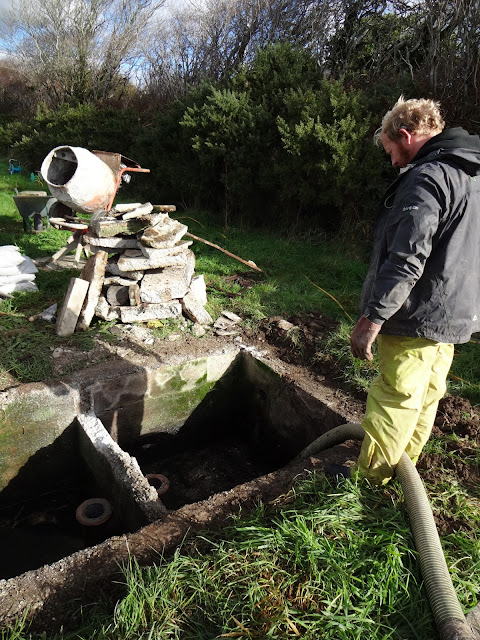
However, back in 2013 just before starting the new house build, a farm worker somehow managed to drive a heavy tractor straight over our septic tank, wrecking the concrete lid, the covers and causing massive structural damage to the whole thing. Great...


Fortunately after some discussion, the farmer who owned the field agreed to take responsibility for the repairs, so we patched up the tank temporarily with some sheet materials to make it safe for any passing people or animals. You really would not want to plunge into that pit of hell!


As the months went by, it became clear that the farmer was struggling to find someone qualified to fix the damage and even more worryingly, now seemed keen on getting his own workers in to effect some kind of repair/bodge.
At the same time, we'd just started digging the foundations of our new house and had just been presented with a whopping bill for the disposal of all the excavated soil. The solution was staring us in the face - we could save thousands if the farmer would agree to take all our excavated soil and in turn he wouldn't have to worry about how to fix the septic tank. As long as we could get it repaired ourselves for less than the cost of the soil disposal, everyone would be happy...
The farmer agreed to the deal so we got the groundworkers to dump all the soil in the field. It made a huge earth bank that stretched several hundred meters.

Working in winter, the dumper truck also churned up the field, turning it into a bit of a swamp. Oops.

A few months later, the farmer had used all our soil to make up new earth banks...

... and over time, nature took care of the rest.

With the build taking up so much of our time, we sidestepped the issue of the broken septic tank for as long as we could but as winter approached, its deteriorating condition meant we had to address it sooner rather than later. Cutting back all the overgrown plants revealed how bad the damage was.



After much to-ing and fro-ing, getting several ludicrously high quotes and a few false starts, we finally employed a local specialist firm to help with the repair. The first step was to remove all the old broken material to get a proper look inside (yuk). It's lucky that Alan volunteered to help Dean with all the work as under the old broken concrete lid, there were two huge slabs of slate which he carefully removed - these look like they could be ideal for outside the front and side doors of the new house (after a good clean of course!)

Once the lid was off, the damage to the top of the tank walls could be properly examined. It didn't look too bad, but we wouldn't know for sure until the tank was emptied.

The tanker arrived...

... dropped a pipe into the field...

... and started pumping out both of the tank's chambers.

Despite its contents, a properly-functioning septic tank is not as stinky as you might think. The 'poop' in the primary chamber forms a crust on top and is broken down by bacteria and micro-organisms. The resulting liquid flows into the second chamber from where it is gradually leached out into the field via a large network of perforated underground pipes.


Luckily the main part of the tank appeared to be undamaged and looked to be in reasonable condition.

Once the tank was emptied, all the rubble and debris from the broken lid needed to be removed from the bottom. Alan wisely chose not to volunteer for this part of the job.

Dean getting down to 'business'... he requested that we didn't flush the toilet while he was in such a perilous position.

After cleaning out the tank, Dean replaced some of the broken pipework.

We used the last few blocks left over from the house build to fix the central wall.

The tank was beginning to look a bit healthier. All it needed now was a new lid.

Dean brought some precast concrete covers which he and Alan hauled manually into place.

Once the three concrete panels were set level, the metal inspection covers could go on.


To finish off, the concrete panels and covers were cemented into place.



We rarely get any tractors in that field but to avoid any possibility of it being driven over again, we erected a small rope fence around the septic tank to let farm workers know it was there.


No comments :
Post a Comment